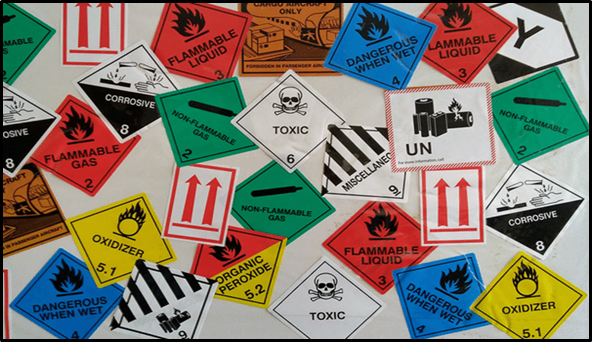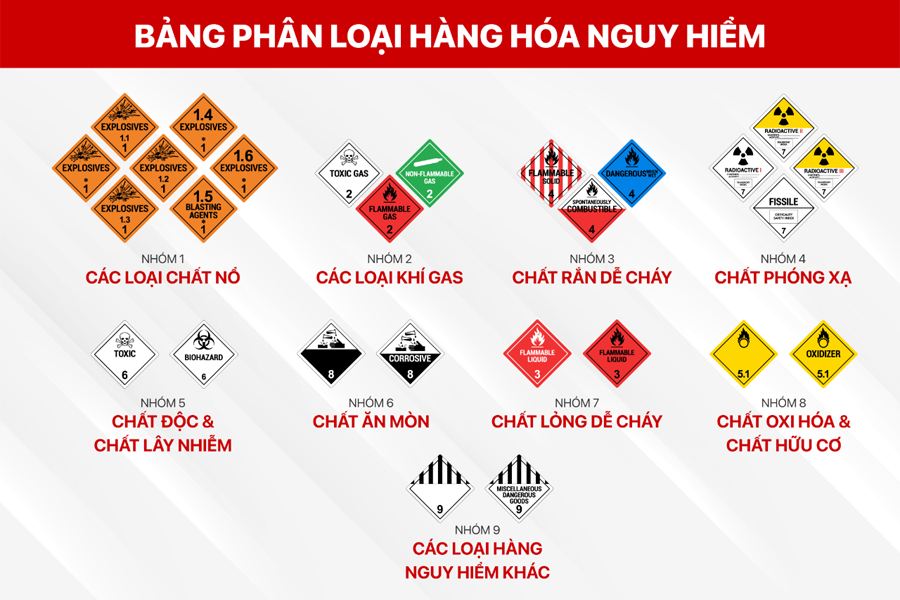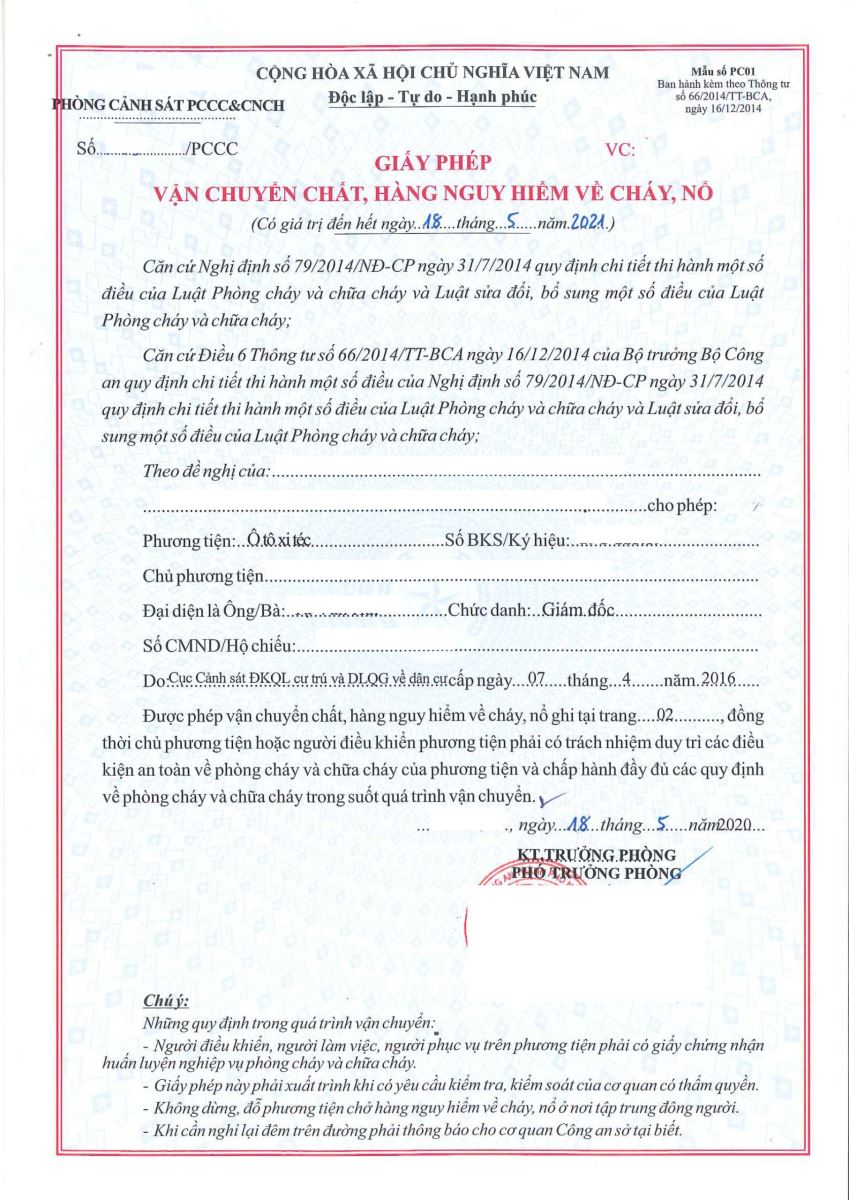I. What are dangerous goods?
Dangerous goods (DG) are items containing toxic substances that affect human health and life, pollute the environment, disrupt national security and order, and endanger traffic during transportation.

II. Classification of dangerous goods.
Based on the SOLAS-74 Convention and the International Maritime Dangerous Goods Code (IMDG Code) proposed by the International Maritime Organization (IMO) for application in 1965, on February 19, 2003, the Government issued Decree No. 13/2003/ND-CP of the Government on the list of dangerous goods. Accordingly, Vietnamese law stipulates that hazardous substances are classified into 9 types and groups, using the United Nations International code UN.
|
Type |
Type Group
|
Content
|
|
1. Explosive Substances or Articles
|
|
|
|
|
1.1
|
Substances with a mass explosion hazard
|
|
|
1.2
|
Substances with a projection hazard but not a mass explosion hazard
|
|
|
1.3
|
Substances with a fire hazard or minor explosion risk, without a mass explosion risk
|
|
|
1.4
|
Substances with no significant risk
|
|
|
1.5
|
Very insensitive substances with a mass explosion risk
|
|
|
1.6
|
Extremely insensitive articles without a mass explosion risk
|
|
2. Gases
|
This group includes compressed gases, liquefied gases, gases in solution, refrigerated liquefied gases, mixtures of one or more gases with one or more vapors of substances from other groups, and containers holding gases, such as tellurium hexafluoride and aerosol cans with a capacity greater than 1 liter
|
|
|
|
2.1
|
Flammable gases (e.g., ethane, butane)
|
|
|
2.2
|
Non-flammable, non-toxic gases (e.g., oxygen, nitrogen)
|
|
|
2.3
|
Toxic gases (e.g., chlorine)
|
|
3. Flammable Liquids
|
Includes liquids that can ignite and burn, meaning liquids with a flash point of less than or equal to 61°C
|
|
|
|
3.1
|
Flammable liquids: These are liquids transported at a temperature equal to or higher than their flash point, or compounds transported in liquid form at high temperatures that emit flammable gases at a temperature equal to or lower than the maximum transport temperature
|
|
|
3.2
|
Liquids with suppressed explosive properties: These are actually explosive compounds that have been dissolved or mixed with water or other liquids, creating a homogeneous liquid mixture to eliminate their explosive characteristics
|
|
4. Dangerous Solid
|
|
Dangerous solids are substances that differ from explosive compounds. Under transport conditions, these substances are always flammable or contribute to causing fires
|
|
|
4.1
|
Flammable Solids
|
|
|
4.2
|
Substances liable to spontaneous Combustion
|
|
|
4.3
|
Substances which, in contact with water, emit flammable gases
|
|
5. Oxidizing Substances and Organic Peroxides
|
|
|
|
|
5.1
|
Flammable oxidizers
|
|
|
5.2
|
Flammable organic peroxides
|
|
6. Toxic Substances or Infectious
|
|
Toxic substances are materials that can cause death, severe injuries, or seriously affect human health if inhaled or come into contact with them
|
|
7. Radioactive Materials
|
|
Radioactive substances are understood as any material containing radioactivity, where either the enriched level of radioactivity or the absolute level of radioactivity declared in the shipment exceeds the specified values outlined in sections 2.7.7.2.1 to 2.7.7.2.6 of the IMDG Code
|
|
8. Corrosive Substances
|
|
These are substances capable of damaging or even destroying other materials, goods, or transportation vehicles if there is leakage or contact due to chemical reactions
|
|
9. Miscellenious Dangerous Substances and Article
|
|
Other harmful substances have dangerous properties according to the provisions in Section A, Chapter VII, SOLAS-74
|

III. Regulations and procedures.
1. Regulations
Dangerous goods, when leaked, threaten human health and life. The loading and unloading process must strictly comply with the regulations of each type of goods and safety supervision. People and means of transport must meet the conditions prescribed in Decree No. 42/2020/ND-CP. The list of goods must be declared correctly according to Appendix I (Attached to Decree No. 42/2020/ND-CP dated April 8, 2020 of the Government), the list of dangerous goods.
And according to this decree, to get the goods, it is mandatory to have a license to transport dangerous goods.
Deploying Centralized Delivery Area
Cat Lai Port has applied many measures to ensure safety in handling dangerous goods.
The port has deployed a centralized delivery area for dangerous goods containers to reduce the risk of fire and explosion and ensure safety during transportation and handling. This requires investment and operations, and the port has announced the unit price for transit services from April 15, 2021.
This unit price is VND 275,000 for a 20-foot container and VND 400,000 for a 40-foot container, including value added tax.
2. Process
A. Apply for a Dangerous Goods Transport Permit
Prepare the application documents:
The carrier of dangerous goods must prepare an application for a Dangerous Goods Transport Permit. The documents must comply with the provisions of Article 17 of Decree No. 42/2020/ND-CP and are divided into different categories of goods as follows:
- Type 5 and Type 8: For dangerous goods of type 5 and type 8, the application must include:
-
Application form for the Dangerous Goods Transport Permit (as per the prescribed model).
-
A copy of the Transport Business License or the Business Registration Certificate.
-
A copy of the list of vehicles participating in the transport, along with a copy of the technical safety and environmental protection certification for the vehicles.
-
A copy of the transport plan for dangerous goods, including the transport route, schedule, and chemical emergency response measures.
- Type 1, Type 2, Type 3, Type 4, and Type 9: For these types of goods, the application must include:
-
Application form for the Dangerous Goods Transport Permit.
-
A copy of the Transport Business License or the Business Registration Certificate.
-
A copy of the list of vehicles participating in the transport, along with a copy of the technical safety and environmental protection certification for the vehicles.
-
A copy of the transport plan for dangerous goods, including the transport route, schedule, and chemical emergency response measures.
- Pesticides: For dangerous goods that are pesticides, the application must include:
-
Application form for the Dangerous Goods Transport Permit.
-
A copy of the Transport Business License or the Business Registration Certificate.
-
A copy of the list of vehicles participating in the transport, along with a copy of the technical safety and environmental protection certification for the vehicles.
-
A copy of the transport plan for dangerous goods.
Submit the application:
After preparing the application documents in accordance with the regulations, the carrier can submit the application either directly to the relevant authority, through postal services, or online via the public service system for document inspection.
Once the documents are reviewed and approved, the Dangerous Goods Transport Permit will be issued to the carrier, authorizing them to legally transport dangerous goods.

B. Receiving FCL dangerous goods:
Receiving and checking documents:
Checking the legality, consistency and completeness of documents such as Commercial Contract, Commercial Invoice, Packing List, Bill of Lading, Letter of Credit (L/C), Dangerous Goods Transport License, Insurance Certificate, Certificate of Origin (C/O), Phytosanitary Certificate, Sanitary Certificate, ensuring that the goods are labeled according to regulations, the label does not cover the type of hazard and secondary hazard, Fumigation Certificate, CA or CQ (if any).
Receiving Arrival and paying D/O fee:
Receiving Arrival Notice and paying Delivery Order (D/O) fee. Payment can be by bank transfer or cash as required by Logistics or Shipping Line.
Electronic customs declaration and tax payment:
-
Use ECUS5/VNACCS software to declare electronic customs (e-customs).
-
Pay tax on the declaration to have a payment slip to the state budget that must be stamped by the bank.
Get D/O order:
Before the ship arrives at the port, receive the arrival notice (Arrival Notice) from the shipping line or forwarder. This notice includes information about the Bill number, shipper, consignee, date of arrival, port of destination code, and warehouse code.
Get the delivery order (D/O) after paying all related fees.
Withdraw the declaration at the declaration return department:
Dangerous Goods Declaration (DGD – or MULTIMODAL DANGEROUS GOODS FORM) with Dangerous Goods Labels
Withdraw the customs declaration (clearance) and the declaration barcode.
Inspection (if red channel account):
-
Register for transfer of inspection yard at the registration point for transfer of inspection yard and emptying at the port commercial office.
-
Cut/stamp the container seal and inspect the goods if necessary.
Clearance of declaration:
Register for transfer of inspection yard and receive back the original declaration, barcode, and stamped EIR.
Hand over EIR and container loan slip to driver:
-
Hand over stamped EIR and container loan slip (empty unloading slip) to driver to pull container from centralized receiving yard for dangerous goods container to warehouse.
Return empty container:
After taking goods to warehouse, the carrier must clean and return empty container to shipping line at the right place and time specified on the container loan slip.
Recover deposit:
The carrier brings the certificate of return of empty container along with the container loan slip to shipping line to get deposit back.
C. Receiving LCL dangerous goods:
Prepare the set of documents
-
Cleared export declaration: Dangerous Goods Declaration (DGD – or MULTIMODAL DANGEROUS GOODS FORM)
-
Commercial Invoice,
-
Packing List, Dangerous Goods Labels (DGL)
-
House Bill of Lading
-
Dangerous Goods Transport License
-
Freight Invoice
Print the warehouse release note
Get a queue number and wait for your turn at the C gate trade office.
Submit the prepared documents, write down the vehicle registration number to print the warehouse release note.
Receive the warehouse release note and the load note.
Note: If the truck is entering Cat Lai port for the first time, it is necessary to provide the Inspection Book for the trade office to import the machine.
After completing this step, inform the warehouse driver of the warehouse gate number (the gate number is written on the slip) and ask the truck driver to drive in.
The new port gate clocks in and lets the truck in.
Pick up the goods
Give the warehouse receipt and the load slip to the warehouse owner, who will scan the location for the forklift to load and take the goods out.
The goods are taken out and signed on the warehouse receipt. Ask the forklift or worker to load the goods onto the truck. Give the load slip to the driver to go out the gate.
For any questions please contact:
Hotline: +84 83 9910066
Mail: info@justintimevn.com